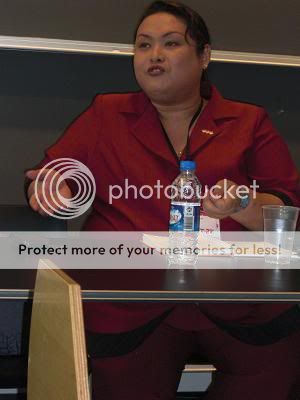If you are the average Filipino, most likely you’ve heard of the LGBT or GLBT or GLTB movement or community in the Philippines. Most likely, as well, you can figure out on your own what the L and G part (which stand for lesbian and gay) are all about. But to review, gay men are men who identify as gay and are emotionally and physically attracted to men. Lesbian women are those who identify as lesbian and are emotionally and physically attracted to women.
Chances are you will be confounded by the B and the T (which stand for bisexual and transgender). A bisexual person is someone who is emotionally and physically attracted to people of both genders. I don’t want to be presumptuous so I will only discuss the T part. Hopefully my avowedly bisexual friends will speak up here to tell us more about bisexuality.
Chances are you will be confounded by the B and the T (which stand for bisexual and transgender). A bisexual person is someone who is emotionally and physically attracted to people of both genders. I don’t want to be presumptuous so I will only discuss the T part. Hopefully my avowedly bisexual friends will speak up here to tell us more about bisexuality.
But before we go any further, let me introduce some key concepts in understanding what transgender means:
Sexual orientation: refers to whom a person is emotionally and physically attracted and that person's choice to act on that attraction. It can be to a person of the same sex (homosexual), opposite sex (heterosexual), both sexes (bisexual), or all kinds of people (polysexual). Now, there are people who identify as asexual. They are people who do not engage in sexual activities that require bodily contact with others.
Gender identity: is a person’s sense of gender whether or not that person is male, female, both or neither.
Gender expression: includes a person's dress, mannerisms, speech patterns, physical appearance, and other acts that express that person's gender. Gender expression may or may not conform to people's expectations of a person.
Gender variance or gender diversity: describes those who choose not to or cannot follow birth-assigned gender norms. More people use the term gender diversity because "variance" has negative connotations.
In the initialism, LGBT, L, G. and B denote sexual orientation. T denotes gender identity or gender expression. So going back, T is for transgender. It was originally coined in the United States and is mistakenly attributed to Virginia Prince, a crossdresser who wanted to describe her desire to change her gender expression but not her anatomy. More than three decades later, the term has now evolved and is understood within and outside LGBT communities around the world as an umbrella term to describe those whose gender identities and/or gender expressions are not traditionally associated with their birth-assigned sex.
In its broadest sense, transgender can describe anybody regardless of sexual orientation, whose appearance, personal characteristics, and behaviors do not fit conventional definitions of “man” and “woman” as they were taught to us. Traditionally, this can include anyone from feminine-acting men or masculine-looking women to people who use hormones and/or surgery to align their bodies with their gender identity. Remember, transgender is not a sexual orientation and thus encompasses a wide range of people who may identify as nonsexual (asexual), heterosexual, homosexual, bisexual and/or polysexual.
In the Philippines, however, the concepts of gender identity and sexual orientation are blurred. It also does not help that the "homosexual" discourse is very strong, which tends to invisibilize those who are transgender. A case in point is the ordinary Miss Gay beauty pageant. Held in almost all villages in the Philippines, a Miss Gay pageant is actually a pageant for transgender women. But because we all grew up knowing only the word gay (what with the word transgender coming to our consciousness only recently), many Miss Gay contestants would actually call themselves gay or homosexual even when they are obviously transgender. This is now slowly changing with trans beauty pageants' increasing use of the word "Queen." So now, we have a pageant in Cebu in the Visayas called, Queen. Another one in Cagayan de Oro in Mindanao is called Miss De Oro Femina. Yet, another one in Antipolo is called Queen of Antipolo. A recently held pageant for transgender women on TV was dubbed, "Queen of Queens." Filipinos are also now aware that pageants for gay men are more appropriately called "Mister Gay."
What confounds this issue more is the existence of indigenous terms for gender diverse people in the Philippines, such as "bakla," which denotes a very effeminate man and "tomboy," which refers to a very masculine woman. These words were originally meant as gender terms and not terms for sexual orientation. Thus, in the Philippines, there is a popular children's rhyme that goes "Girl, Boy, Bakla, Tomboy," an articulation of a hierarchical gender system. Filipino children use this nonsense rhyme to make fun of those who are "bakla" or "tomboy" in a game of random tag.
With the advent of psychology, anthropology and sexology in the Philippines starting in the 60s, "bakla" and "tomboy" were misinterpreted as equivalent to sexual identities in the West. "Bakla" became gay and "tomboy" became lesbian. This is unfortunate since this misinterpretation did not capture the nuance of many "bakla" claiming to be "pusong babae" or having the heart of a woman. In the same vein, many of those who called themselves "tomboy" would say they were "pusong lalake" or had the heart of man. A "bakla" who is emotionally and physically attracted to a man would therefore technically be straight. In the same way that a "tomboy" who is emotionally and physically attracted to a woman had a heterosexual orientation. Science would insist, however, that they were simply gay or lesbian respectively.
Furthermore, all others who were not named in the hierarchy that was "Girl, Boy, Bakla, Tomboy" were subsumed under these indigenous terms as well. Transgender women or transwomen were also "bakla" and therefore gay; while transgender men or transmen were also "tomboy" and therefore lesbian. These indigenous terms were already inherently derogatory as demonstrated by the nonsense rhyme above. In the Philippines, "bakla" and "tomboy" form the lesser rungs of a pecking order. When they took on the additional layer of denoting sexual identity or sexual orientation, they turned even more pejorative. So, when someone uses these terms to disparage another person, it is meant to express disgust not only at the person's gender identity or expression but as well as that person's presumed sexual proclivities.
It is no surprise then that many of those who call themselves transgender in the modern sense in the Philippines tend to veer away from the use of these terms to call themselves with. Many transwomen are uncomfortable to be called "bakla," while transmen virulently oppose the use of "tomboy" in referring to themselves. This is understandable since to many transwomen, they are clearly female or just girls; while to many transmen, they are most definitely male or just boys. Again, the larger society would insist that they were simply "gay/bakla" or "lesbian/tomboy" respectively.
There is also a difference in stance on these terms among Filipino gay men and lesbian women. Some gay men still use "bakla" to refer to themselves, while some lesbians still use "tomboy." But in general, Filipino gay men just call themselves "gay," while lesbian Filipinas call themselves, "lesbiyana" or "lesbyana." Many transgender women continue to use the term "bakla" and other indigenous terms like "bayot" in the Visayas and "bantut" in Mindanao to refer to themselves. The same goes for transgender men who use the word "tomboy" to identify themselves. Although, I am aware of only very few who do so. What is the difference between a gay man and transgender woman who both call themselves "bakla"? Simply, the gay man is a man; while the transgender woman is a woman. What is the difference between a lesbian woman and transman who both call themselves "tomboy"? The lesbian is a woman while the transman is a man. Ideally, there should be no quarrel over this. Self-identification is a highly personal act. In the end, only a person could decide what term or name is right for him or her. Today, more and more people in the Philippines understand what it means to be transgender and Filipino. They understand that a Filipino transgender woman is a woman, and a Filipino transgender man is a man.
More importantly though, if ordinary Filipinos can decide for themselves who they are and what to call themselves with, then LGBT Filipinos have every right to do so, too. This is called self-determination, a cornerstone principle of liberation that has given birth not only to nations but as well as to social justice movements the world over.
Sexual orientation: refers to whom a person is emotionally and physically attracted and that person's choice to act on that attraction. It can be to a person of the same sex (homosexual), opposite sex (heterosexual), both sexes (bisexual), or all kinds of people (polysexual). Now, there are people who identify as asexual. They are people who do not engage in sexual activities that require bodily contact with others.
Gender identity: is a person’s sense of gender whether or not that person is male, female, both or neither.
Gender expression: includes a person's dress, mannerisms, speech patterns, physical appearance, and other acts that express that person's gender. Gender expression may or may not conform to people's expectations of a person.
Gender variance or gender diversity: describes those who choose not to or cannot follow birth-assigned gender norms. More people use the term gender diversity because "variance" has negative connotations.
In the initialism, LGBT, L, G. and B denote sexual orientation. T denotes gender identity or gender expression. So going back, T is for transgender. It was originally coined in the United States and is mistakenly attributed to Virginia Prince, a crossdresser who wanted to describe her desire to change her gender expression but not her anatomy. More than three decades later, the term has now evolved and is understood within and outside LGBT communities around the world as an umbrella term to describe those whose gender identities and/or gender expressions are not traditionally associated with their birth-assigned sex.
In its broadest sense, transgender can describe anybody regardless of sexual orientation, whose appearance, personal characteristics, and behaviors do not fit conventional definitions of “man” and “woman” as they were taught to us. Traditionally, this can include anyone from feminine-acting men or masculine-looking women to people who use hormones and/or surgery to align their bodies with their gender identity. Remember, transgender is not a sexual orientation and thus encompasses a wide range of people who may identify as nonsexual (asexual), heterosexual, homosexual, bisexual and/or polysexual.
In the Philippines, however, the concepts of gender identity and sexual orientation are blurred. It also does not help that the "homosexual" discourse is very strong, which tends to invisibilize those who are transgender. A case in point is the ordinary Miss Gay beauty pageant. Held in almost all villages in the Philippines, a Miss Gay pageant is actually a pageant for transgender women. But because we all grew up knowing only the word gay (what with the word transgender coming to our consciousness only recently), many Miss Gay contestants would actually call themselves gay or homosexual even when they are obviously transgender. This is now slowly changing with trans beauty pageants' increasing use of the word "Queen." So now, we have a pageant in Cebu in the Visayas called, Queen. Another one in Cagayan de Oro in Mindanao is called Miss De Oro Femina. Yet, another one in Antipolo is called Queen of Antipolo. A recently held pageant for transgender women on TV was dubbed, "Queen of Queens." Filipinos are also now aware that pageants for gay men are more appropriately called "Mister Gay."
What confounds this issue more is the existence of indigenous terms for gender diverse people in the Philippines, such as "bakla," which denotes a very effeminate man and "tomboy," which refers to a very masculine woman. These words were originally meant as gender terms and not terms for sexual orientation. Thus, in the Philippines, there is a popular children's rhyme that goes "Girl, Boy, Bakla, Tomboy," an articulation of a hierarchical gender system. Filipino children use this nonsense rhyme to make fun of those who are "bakla" or "tomboy" in a game of random tag.
With the advent of psychology, anthropology and sexology in the Philippines starting in the 60s, "bakla" and "tomboy" were misinterpreted as equivalent to sexual identities in the West. "Bakla" became gay and "tomboy" became lesbian. This is unfortunate since this misinterpretation did not capture the nuance of many "bakla" claiming to be "pusong babae" or having the heart of a woman. In the same vein, many of those who called themselves "tomboy" would say they were "pusong lalake" or had the heart of man. A "bakla" who is emotionally and physically attracted to a man would therefore technically be straight. In the same way that a "tomboy" who is emotionally and physically attracted to a woman had a heterosexual orientation. Science would insist, however, that they were simply gay or lesbian respectively.
Furthermore, all others who were not named in the hierarchy that was "Girl, Boy, Bakla, Tomboy" were subsumed under these indigenous terms as well. Transgender women or transwomen were also "bakla" and therefore gay; while transgender men or transmen were also "tomboy" and therefore lesbian. These indigenous terms were already inherently derogatory as demonstrated by the nonsense rhyme above. In the Philippines, "bakla" and "tomboy" form the lesser rungs of a pecking order. When they took on the additional layer of denoting sexual identity or sexual orientation, they turned even more pejorative. So, when someone uses these terms to disparage another person, it is meant to express disgust not only at the person's gender identity or expression but as well as that person's presumed sexual proclivities.
It is no surprise then that many of those who call themselves transgender in the modern sense in the Philippines tend to veer away from the use of these terms to call themselves with. Many transwomen are uncomfortable to be called "bakla," while transmen virulently oppose the use of "tomboy" in referring to themselves. This is understandable since to many transwomen, they are clearly female or just girls; while to many transmen, they are most definitely male or just boys. Again, the larger society would insist that they were simply "gay/bakla" or "lesbian/tomboy" respectively.
There is also a difference in stance on these terms among Filipino gay men and lesbian women. Some gay men still use "bakla" to refer to themselves, while some lesbians still use "tomboy." But in general, Filipino gay men just call themselves "gay," while lesbian Filipinas call themselves, "lesbiyana" or "lesbyana." Many transgender women continue to use the term "bakla" and other indigenous terms like "bayot" in the Visayas and "bantut" in Mindanao to refer to themselves. The same goes for transgender men who use the word "tomboy" to identify themselves. Although, I am aware of only very few who do so. What is the difference between a gay man and transgender woman who both call themselves "bakla"? Simply, the gay man is a man; while the transgender woman is a woman. What is the difference between a lesbian woman and transman who both call themselves "tomboy"? The lesbian is a woman while the transman is a man. Ideally, there should be no quarrel over this. Self-identification is a highly personal act. In the end, only a person could decide what term or name is right for him or her. Today, more and more people in the Philippines understand what it means to be transgender and Filipino. They understand that a Filipino transgender woman is a woman, and a Filipino transgender man is a man.
More importantly though, if ordinary Filipinos can decide for themselves who they are and what to call themselves with, then LGBT Filipinos have every right to do so, too. This is called self-determination, a cornerstone principle of liberation that has given birth not only to nations but as well as to social justice movements the world over.












